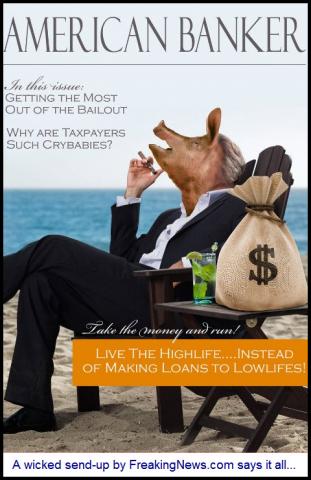
It’s Bank Lobbyists vs. American Families In Fight For Financial Reform
In his latest salvo against Wall Street, Rolling Stone’s Matt Taibbi argues that the recent resurgence of the banking sector is the result of nothing more than a series of Depression-Era con jobs.
In Taibbi’s words, Wall Street has delivered “the best 18 months of grifting this country has ever seen.”
Taibbi is certainly fond of colorful metaphors. Over the last year, he famously (or infamously) compared Goldman Sachs to a “vampire squid.” And in “Obama’s Big Sellout,” he railed against the free-market beliefs and political influence of former Citigroup Chairman and Treasury Secretary Robert Rubin.
Pointing to seven decidedly old time swindles in “Wall Street’s Bailout Hustle,” Taibbi is quick to blast the banks’ antics during and after the bailout. The rescue of AIG, Taibbi argues, which sent $13 billion to Goldman Sachs, was essentially a “Swoop and Squat” con — a scam that involves intentionally causing a car crash and bilking an insurance company.
Goldman Sachs intentionally drove AIG into insolvency so that it could collect on its massive derivatives contracts, Taibbi argues:
“It was a brilliant move. When a company like AIG is about to die, it isn’t supposed to hand over big hunks of assets to a single creditor like Goldman; it’s supposed to equitably distribute whatever assets it has left among all its creditors…Instead, Goldman and the other counterparties got their money out in advance — putting a torch to what was left of AIG. Fans of the movie Goodfellas will recall Henry Hill and Tommy DeVito taking the same approach to the Bamboo Lounge nightclub they’d been gouging. Roll the Ray Liotta narration: “Finally, when there’s nothing left, when you can’t borrow another buck . . . you bust the joint out. You light a match.”
Throughout the piece Taibbi is more concerned with the conceptual basis of Wall Street’s windfall, rather than the subtitles and unintended consequences of programs like the Public-Private Investment Program (PPIP), or the Temporary Liquidity Guarantee Program.
Taibbi’s critics have pointed to what they say is a tendency to oversimplify, to play fast and loose with the facts and his continued focus on Goldman Sachs. In a blistering piece for The Big Money Heidi Moore assessed Taibbi’s Goldman Sachs piece as having a “lively, if incoherent, narrative.”
Con artists have a word for the inability of their victims to accept that they’ve been scammed. They call it the “True Believer Syndrome.” That’s sort of where we are, in a state of nagging disbelief about the real problem on Wall Street. It isn’t so much that we have inadequate rules or incompetent regulators, although both of these things are certainly true. The real problem is that it doesn’t matter what regulations are in place if the people running the economy are rip-off artists. The system assumes a certain minimum level of ethical behavior and civic instinct over and above what is spelled out by the regulations. If those ethics are absent — well, this thing isn’t going to work, no matter what we do. Sure, mugging old ladies is against the law, but it’s also easy. To prevent it, we depend, for the most part, not on cops but on people making the conscious decision not to do it.
That’s why the biggest gift the bankers got in the bailout was not fiscal but psychological. “The most valuable part of the bailout,” says Rep. Sherman, “was the implicit guarantee that they’re Too Big to Fail.” Instead of liquidating and prosecuting the insolvent institutions that took us all down with them in a giant Ponzi scheme, we have showered them with money and guarantees and all sorts of other enabling gestures. And what should really freak everyone out is the fact that Wall Street immediately started skimming off its own rescue money. If the bailouts validated anew the crooked psychology of the bubble, the recent profit and bonus numbers show that the same psychology is back, thriving, and looking for new disasters to create. “It’s evidence,” says Rep. Kanjorski, “that they still don’t get it.”
More to the point, the fact that we haven’t done much of anything to change the rules and behavior of Wall Street shows that we still don’t get it. Instituting a bailout policy that stressed recapitalizing bad banks was like the addict coming back to the con man to get his lost money back. Ask yourself how well that ever works out. And then get ready for the reload.
Read Matt Taibbi’s entire piece here.